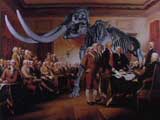
NEWS

From Hyde Park to Jurassic
Park
The recent excavation of a well-preserved mastodon skeleton at Hyde Park, New York, by Cornell paleontologists suddenly made this Ice Age creature headline news. Warren Allmon, Director of the Paleontological Research Institute (PRI) at Cornell led a team of professional bone hunters in a well-publicized dig in the backyard of Larry and Laura Lozier's suburban Hyde Park home, where workmen digging a pond had turned up the aimal's giant thighbone.
The Hyde Park story created quite a media splash. CNN filmed the dig, the Discovery Channel prepared a documentary, Tom Brokaw mentioned the discovery on the NBC Nightly News, and People magazine devoted a full page to the event, featuring a photo of the mud-splattered Lozier family digging for bones in their backyard pit.
At PRI's website, Cornell geologist John Chiment called the extensive media coverage a "Mastodon renaissance" comparable to the recent rebirth of interest in dinosaurs. "I see an exact parallel with what happened with dinosaurs 30 years ago," he told the Ithaca Times.
Unfortunately, few people today are aware that George Washington visited a similar Hudson River site during the American Revolution to examine bones like those of the Hyde Park mastodon. In the winter of 1780, when the Continental Army was camped near West Point, General Washington journeyed across the snow-cover countryside in a horse-drawn sleigh to view the enormous teeth of a mysterious animal dug up on a nearby farm.
Two decades later, in 1801, Charles Willson Peale, the Philadelphia painter and museum proprietor, dug up the first complete skeleton of the American monster on a farm in the Hudson River valley near Newbugh. Moreover, the climax to the mastodon's story came nearly a century after the discovery of a giant tooth on the banks of the Hudson river north of the present day town of Hudson.
There are few historical markers in the Hudson River valley to commemorate these events and the American monster has disappeared from the region's folklore, not to mention the nation's history books.
In the current age of Jurassic Park dinosaurs, the jaws of Tyrannosaurus rex have replaced the mastodon's grinders as symbols of dominance. When paleontologists dream of cloning the Siberian mammoth with DNA extracted from its frozen carcass, Paul Semonin's American Monster sheds new light on the fantasies of absolute power associated with the resurrection of prehistoric monsters.
© 2003 Paul Semonin
ABC
World News Tonight

On July 4, 2002
anchorman Peter Jennings
featured Paul Semonin's
American Monster
on the evening news.
Speaking
from the lawn
at Mount Vernon
he called viewers attention
to the untold story of
the Founding Fathers'
fascination with the nation's
first prehistoric monster.
Unfortunately,
ABC's timely
report on the mastodon
ignored the fact that many
American patriots believed
the animal to be an elephant
with claws that devoured
buffalo, deer and elk.
Instead,
ABC presented the great beast as a harmless
herbivore, a mascot
rather than a symbol of
violent conquest
and domination.
For
the true story
of the mastodon's discovery
and its symbolism
in the new republic
READ
American Monster.